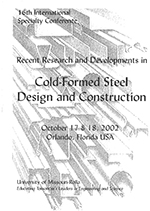Session Dates
17 Oct 2002
Abstract
An investigation on the ultimate and service load capacity of cold-formed steel lipped C-section studs for the wall system is presented. An experimental research has been carried out to study the structural behavior of stud assembly subjected to lateral loads. Each test specimen consisted of three or four lipped C-section studs and two C-section tracks which restrain both ends of wall studs from rotation. The effects of main parameters, such as perforation on the web, space of bridge channel and special clip to fix the bridge channel and to sustain the distance between lips, were studied in the experimental work. The effect of gypsum board and ply wood attached to tension flanges was also investigated. The test strength capacity was compared with the nominal flexural strength and lateral buckling strength based on the AISI Specifications (1996).
Department(s)
Civil, Architectural and Environmental Engineering
Research Center/Lab(s)
Wei-Wen Yu Center for Cold-Formed Steel Structures
Meeting Name
16th International Specialty Conference on Cold-Formed Steel Structures
Publisher
University of Missouri--Rolla
Document Version
Final Version
Rights
© 2002 University of Missouri--Rolla, All rights reserved.
Document Type
Article - Conference proceedings
File Type
text
Language
English
Recommended Citation
Song, Jun-Yeup; Chung, Hyun Suk; Kim, Gap Deuk; and Kwon, Young Bonb, "A Study on the Flexural Strength Capacity of Wall Stud Assembly" (2002). CCFSS Proceedings of International Specialty Conference on Cold-Formed Steel Structures (1971 - 2018). 1.
https://scholarsmine.mst.edu/isccss/16iccfss/16iccfss-session7/1
A Study on the Flexural Strength Capacity of Wall Stud Assembly
An investigation on the ultimate and service load capacity of cold-formed steel lipped C-section studs for the wall system is presented. An experimental research has been carried out to study the structural behavior of stud assembly subjected to lateral loads. Each test specimen consisted of three or four lipped C-section studs and two C-section tracks which restrain both ends of wall studs from rotation. The effects of main parameters, such as perforation on the web, space of bridge channel and special clip to fix the bridge channel and to sustain the distance between lips, were studied in the experimental work. The effect of gypsum board and ply wood attached to tension flanges was also investigated. The test strength capacity was compared with the nominal flexural strength and lateral buckling strength based on the AISI Specifications (1996).



